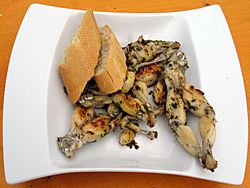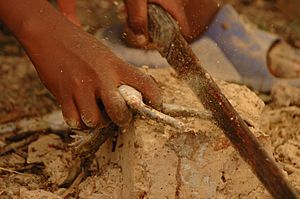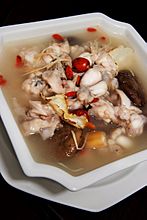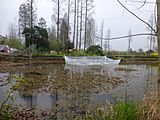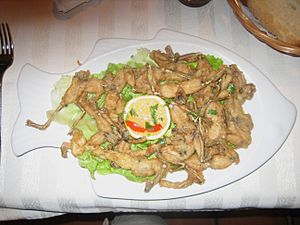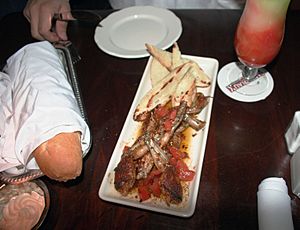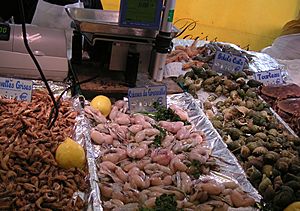Frog legs facts for kids
De grenouille
Frog legs are a special food, often called a delicacy. They are the legs of certain types of edible frogs. In French cuisine, frog legs (called Cuisses de grenouille) are very famous and seen as a national dish.
People eat frog legs in many other places around the world too! This includes countries like Vietnam, Southern China, Cambodia, Thailand, Indonesia, Korea, and parts of Europe like Northern Italy, Portugal, Spain, and Greece. You can also find them in South Africa and the Southern United States.
As of 2014, Indonesia was the biggest exporter of edible frogs. China was second, and Turkey was third. In some countries like Turkey, Brazil, Mexico, and the Caribbean, many frogs are still caught in the wild for food.
Frog legs are healthy! They have lots of protein, omega-3 fatty acids, vitamin A, and potassium. Many people say they taste like chicken because they have a mild flavor. Their texture is often compared to chicken wings. The taste and texture are somewhere between chicken and fish. Some countries, like Vietnam, even raise frogs on farms just for food.
Contents
- Frog Legs Around the World
- France: A Classic Dish
- China: "Field Chicken"
- Indonesia: Swikee Soup
- Italy: Rice Field Delicacy
- Slovenia: Traditional Dish
- Croatia: Gorski Kotar Specialty
- Spain: Deep-Fried Delight
- Albania: Wild-Caught Treat
- Greece: Ioannina's Famous Dish
- Romania: "Pond Chicken"
- United States: Southern Delicacy
- Caribbean: Mountain Chicken
- United Kingdom: A Surprising History
- Australia, New Zealand, and Canada
- Important Considerations
- See also
Frog Legs Around the World
France: A Classic Dish
In France, frog legs are known as cuisses de grenouille. This dish is very traditional, especially in a region called the Dombes. People have been eating them in France for over a thousand years! It's a big part of their national food history. French people eat about 4,000 tonnes of frog legs every year.
China: "Field Chicken"
In China, frog legs are also eaten, especially in Southern Chinese cooking, like Cantonese cuisine. People often call them "field chicken" (「田鸡」). Large farms in areas like Sichuan raise bullfrogs and pig frogs for food.
In Chinese cooking, frog legs are usually stir-fried with light spices. They can also be stewed, fried, or made into a thick rice porridge called congee. This is a popular dish in Cantonese cooking.
-
Frogs being raised for food in a small plastic enclosure in a pond in Hubei, China
Indonesia: Swikee Soup

In Indonesian cuisine, frog-leg soup is called swikee or swike. It was likely brought to Indonesia by the Chinese community. Swikee is a soup with a strong taste of garlic, ginger, and fermented soybeans (tauco). It's often served with celery or parsley. This dish is very popular in Purwodadi Grobogan, in Central Java.
Other ways to eat frog legs in Indonesia include frying them in margarine with sweet soy sauce or tomato sauce. They can also be battered and deep-fried, grilled, or even served as frog eggs wrapped in banana leaves (pepes telur kodok). Even the crispy fried frog skin is eaten as a cracker called krupuk, which tastes a bit like fried fish skin.
Indonesia is the world's biggest exporter of frog meat. They send over 5,000 tonnes of frog meat each year, mostly to France, Belgium, and Luxembourg. Most frog legs in Western Europe come from Indonesian frog farms. However, some people worry that frogs are being taken from the wild, which could harm wild frog populations.
Italy: Rice Field Delicacy
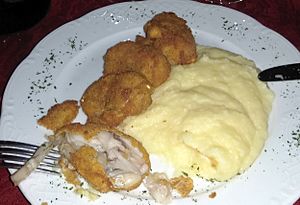
Frogs are a common food in northern Italy, especially in regions like Piemonte and Lombardy. In these areas, frogs have been a traditional food for a long time. People eat them because frogs are plentiful due to the local farming.
The large number of frogs is mainly because of rice farming. Rice fields need a lot of water, so there are many artificial water channels. These channels create a perfect home for frogs. When the fields are flooded, and especially when they are drained, farmers and others often go hunting for frogs with nets. Some towns even have frog hunting events and games.
Frogs are so important in these areas that many towns hold food festivals called sagre focused on frogs. These festivals usually happen during the rice harvest. Since frog eating is linked to rice production, and this is where risotto comes from, one popular dish is frog risotto, called risotto alle rane. Other local frog dishes include fried frog legs dipped in egg batter and breadcrumbs, or frogs in soups and stews.
Slovenia: Traditional Dish
Frog legs (žabji kraki) are a popular dish in Slovenian cuisine. They are especially common in eastern Slovenia and in the capital city, Ljubljana. For a long time, they were considered a special food for Lent (a Christian fasting period) and were very popular in spring. You can also find them in the Vipava Valley in western Slovenia.
Croatia: Gorski Kotar Specialty
Frog legs are popular in some parts of Croatia, particularly in the Gorski kotar region. They are a special dish in the Lokve area. Here, frog legs are served cooked, fried, or in a stew, sometimes with polenta (a cornmeal dish).
Spain: Deep-Fried Delight
In western Spain, in regions like Extremadura and Castilla y Leon, frog legs are often served deep-fried. They are considered a delicious treat by local people. Frog legs are also a valued food along the Ebro River.
Albania: Wild-Caught Treat
In Albania, frog legs are seen as a very tasty food. Most of the frogs eaten here are caught from the wild.
Greece: Ioannina's Famous Dish
In Greece, eating frog legs is especially linked to the city of Ioannina and its nearby lake, Pamvotida.
Romania: "Pond Chicken"
In Romania, edible frogs are called pui de baltă, which means "pond chicken." The legs are usually breaded and fried.
United States: Southern Delicacy
Frog legs are eaten in parts of the Southern United States, especially in the Deep South and Gulf states. This is where French culture has had a strong influence. States like South Carolina, Georgia, Florida, Alabama, Mississippi, and Louisiana enjoy them. They are also eaten in Eastern states, but less commonly.
Popular types of frogs eaten are bullfrogs and leopard frogs, as these are common in most of the country. While it's generally not encouraged to eat wild native frogs, catching and cooking invasive bullfrogs, especially in the Western US, is sometimes suggested to help control their numbers and promote local food.
Frog legs are often prepared by coating them in egg and cracker crumbs or a batter. They are then either fried or grilled. You can also find deep-fried frog legs at fairs.
Caribbean: Mountain Chicken
The Mountain chicken (Leptodactylus fallax) is a type of frog named for where it lives and its flavor. These frogs are eaten in Montserrat and Dominica. Sadly, these frogs are now critically endangered.
United Kingdom: A Surprising History
Archaeologists found cooked frog leg bones in Amesbury, Wiltshire, United Kingdom. These bones date back to between 7596 and 6250 BC. This suggests that Britons might have eaten frog legs even before the French!
However, for many centuries, British people thought frogs were disgusting, partly because of their rivalry with the French. "Frog" even became a rude nickname for a French person in the late 1700s. In the late 1800s, a French chef named Auguste Escoffier tried to call them "nymphs" to make them sound better to London diners, but it didn't work. In recent years, some adventurous British chefs, like Heston Blumenthal, have started putting frog leg dishes on their menus.
Australia, New Zealand, and Canada
In Australia and New Zealand, frog legs are considered more exotic. They are usually found in Asian or French restaurants, and mainly the back legs are eaten. In Canada, they are a bit more common, especially in eastern and northeastern parts of the country.
Important Considerations
Global Trade of Frog Legs
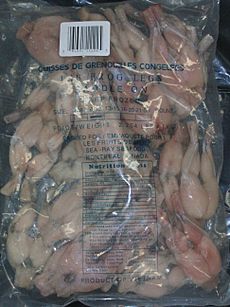
Every year, about US$40 million worth of frog legs are bought and sold internationally. Many countries around the world are part of this trade. The biggest buyers of frog legs are France, Belgium, and the United States. The largest sellers are Indonesia and China.
When you include frogs raised on farms, it's estimated that people eat up to 3.2 billion frogs for food worldwide each year.
Protecting Frogs and Their Homes
Many environmental groups ask people to eat fewer frogs, especially those caught in the wild. This is because frog populations are shrinking, and frogs are a very important part of our natural world. They warn that the demand for frogs for food is seriously reducing their numbers in different regions. Frogs are sensitive to changes in their environment, diseases, and pollution.
However, there's an exception: the American bullfrog. In places where it's not native and has been introduced, it can harm local frog populations and other wildlife. In these areas, catching and eating bullfrogs can actually help balance the ecosystem.
Some people are also concerned about how frogs are caught and prepared for food. They suggest that countries should have rules to make sure frogs are caught and handled in a way that causes the least amount of suffering.
Religious Views on Eating Frogs
Some religions have rules about what foods can be eaten. In Jewish dietary laws, frogs are considered unclean animals, so frog legs are not kosher and are forbidden for observant Jews. Also, Jewish law forbids eating parts taken from live animals, which would apply to frog legs if they were removed while the frog was still alive. This is also seen as being unkind to animals.
For some Islamic dietary laws, frog meat is considered haraam (not allowed). This is based on religious texts that forbid killing frogs, along with certain other animals. This view has caused discussions in places like Demak, Indonesia, where authorities asked restaurants not to link frog leg soup (swikee) with the city's image as an Islamic city. However, there are different opinions within Islamic law about eating frogs. Some schools of thought strictly forbid it, while others might allow certain types of frogs.
In medieval and early modern Europe, frogs were not seen as "meat." This meant they could be eaten during the Christian fast of Lent, along with fish and birds. Monks in France were recorded eating frogs during Lent in the 13th century.
|
See also
 In Spanish: Ancas de rana para niños
In Spanish: Ancas de rana para niños


